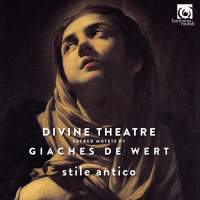Texte paru dans: / Appeared in: |
|
|
Outil de traduction ~ (Très approximatif) |
|
|
Reviewer:
Barry Brenesal
J. F. Weber noted in a review
of Giaches de Wert’s music just under 30 years ago (Kontrapunkt 32001;
Fanfare 12:2) that the composer was poorly represented in the active catalog.
I wish I could say this situation has changed over the years, but it hasn’t.
Despite the general agreement among musicians then and musicologists now
regarding the quality and central importance of his works—especially his
madrigals—Wert continues to fare poorly on disc. I find only two discs of
his sacred music easily available at the current time in physical format,
and recorded in the last decade: the composer’s first book of motets, some
of which were recorded in an over-reverberant acoustic by Anthony Zielhorst
and Collegium Musicum Amsterdam (Brilliant Classics 94684), and his second
book of motets, featuring Stephen Cleobury and Collegium Regale (Signum
131). More is due, for Wert wrote to excellent effect in both the
conservative style of his day and also its most progressive, or what later
generations would term prima pratica and seconda pratica. The former is of
course the polyphonic style of the time, perhaps best exemplified in
Palestrina, who was only a decade older than Wert. The latter allowed
composers to freely experiment with harmonic and polyphonic effects, the
better to make the music expressive as the term is currently understood. And
although at a distance it’s possible to see that these two approaches formed
part of a continuum, their advocates tended to portray them as diametric
opposites, music over words versus words over music.
It’s been suggested that Wert
(who was Italian in all respects save his name, having been brought to Italy
as a child, and raised near Naples) had a natural reason for the two
disparate musical styles of his sacred music. On the one hand, he spent
nearly all of his active career in service to the Gonzagas of Mantua, a city
that was artistically invigorated by the spirit of the Counter-Reformation
and culturally conservative. But he was drawn later in life to the
progressive court of the Gonzaga’s cousins, the Estes of Ferrara, where he
had a lengthy affair with Tarquinia Molza, soprano, composer, poet, and one
of the noble ladies-in-waiting to the Duchess. Wert would have encountered
the seconda pratica madrigalist Luzzasco Luzzaschi there, serving as
organist, as well as many other celebrated representatives of the arts in
music and literature. Receiving commissions or seeking funds for
publications in both cities, Mantua and Ferrara, would have meant writing in
the two most prominent Italian fashions of sacred music in his day. And as
this album demonstrates, Wert did so expertly in his sacred music—or at
least, imbued the essentially contrapuntal textures of prima pratica with
the results of the seconda pratica’s expressive experimentation. Both the Gaudete in Domino and Virgo Maria hodie are examples of Wert as a master of the Franco-Flemish school, his textures complex and luminous, festive and tenderly serene, respectively. By contrast, Vox in Rama plays off emotional effects caused by a scale that includes the major and minor thirds, used in close juxtaposition. Ascendente Jesu in naviculam has numerous instances of clever madrigalism: a clear, simple, joyous ascent by Jesus and his disciples into the boat, its open textures and carefully measured beats a setup for the increasingly imitative points and disruptive syncopation that denote a furious storm of tumbling parallel fifths. It never descends into a series of discrete effects, thanks to Wert’s ability to effortlessly sustain counterpoint within what could be seen as a series of continuous variations.
Stile
Antico is represented on this disc by 13 of its singers. Five-voiced motets
are performed by the entire ensemble, but six- and eight-voiced ones break
out smaller groups for one singer per part, which makes sense, given the
greater complexity of Wert’s textures. The singing is expert, as is the
enunciation of the text, and the subtlety with which individual parts are
emphasized to bring out salient musical or literary points. The disc’s
miking is close, catching the rich overtones of the voices, and the venue of
All Hallows’ Church, Gospel Oak, London, avoids the swamp of cathedral sound
that damages so many other otherwise fine albums of choral music.
Recommended for music, performances, and sound. | |
|
Support us financially by purchasing this disc from eiher one of these suppliers. Un achat via l'un ou l'autre des fournisseurs proposés contribue à défrayer les coûts d'exploitation de ce site. |
|
|
|
|
|
Cliquez l'un ou l'autre
bouton pour découvrir bien d'autres critiques de CD |
|




